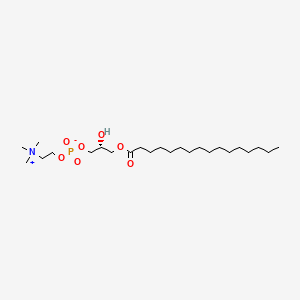| MeSH term | MeSH ID | Detail |
|---|---|---|
| Hemolysis | D006461 | 131 associated lipids |
| Arrhythmias, Cardiac | D001145 | 42 associated lipids |
| Diabetes Mellitus, Type 1 | D003922 | 56 associated lipids |
1-Palmitoyl-sn-glycero-3-phosphocholine
1-Palmitoyl-sn-glycero-3-phosphocholine is a lipid of Glycerophospholipids (GP) class. 1-palmitoyl-sn-glycero-3-phosphocholine is associated with abnormalities such as Intrahepatic Cholestasis and Dysentery, Shigella dysenteriae. The involved functions are known as Homeostasis, Signal Transduction, Saturated, mRNA Expression and Synthesis. 1-palmitoyl-sn-glycero-3-phosphocholine often locates in Hepatic. The associated genes with 1-Palmitoyl-sn-glycero-3-phosphocholine are PPARA gene, TGFBR2 gene, SMAD3 gene and PLA2G6 gene. The related lipids are Fatty Acids, palmitoyl lysophosphatidylcholine, LYSO-PC and 1-palmitoyl-2-hydroxy-sn-glycero-3-phosphocholine.
Cross Reference
Introduction
To understand associated biological information of 1-Palmitoyl-sn-glycero-3-phosphocholine, we collected biological information of abnormalities, associated pathways, cellular/molecular locations, biological functions, related genes/proteins, lipids and common seen animal/experimental models with organized paragraphs from literatures.
What diseases are associated with 1-Palmitoyl-sn-glycero-3-phosphocholine?
1-Palmitoyl-sn-glycero-3-phosphocholine is suspected in Intrahepatic Cholestasis, Dysentery, Shigella dysenteriae and other diseases in descending order of the highest number of associated sentences.
Related references are mostly published in these journals:
| Disease | Cross reference | Weighted score | Related literature |
|---|
Possible diseases from mapped MeSH terms on references
We collected disease MeSH terms mapped to the references associated with 1-Palmitoyl-sn-glycero-3-phosphocholine
PubChem Associated disorders and diseases
What pathways are associated with 1-Palmitoyl-sn-glycero-3-phosphocholine
There are no associated biomedical information in the current reference collection.
PubChem Biomolecular Interactions and Pathways
Link to PubChem Biomolecular Interactions and PathwaysWhat cellular locations are associated with 1-Palmitoyl-sn-glycero-3-phosphocholine?
Visualization in cellular structure
Associated locations are in red color. Not associated locations are in black.
Related references are published most in these journals:
| Location | Cross reference | Weighted score | Related literatures |
|---|
What functions are associated with 1-Palmitoyl-sn-glycero-3-phosphocholine?
Related references are published most in these journals:
| Function | Cross reference | Weighted score | Related literatures |
|---|
What lipids are associated with 1-Palmitoyl-sn-glycero-3-phosphocholine?
Related references are published most in these journals:
| Lipid concept | Cross reference | Weighted score | Related literatures |
|---|
What genes are associated with 1-Palmitoyl-sn-glycero-3-phosphocholine?
Related references are published most in these journals:
| Gene | Cross reference | Weighted score | Related literatures |
|---|
What common seen animal models are associated with 1-Palmitoyl-sn-glycero-3-phosphocholine?
There are no associated biomedical information in the current reference collection.
NCBI Entrez Crosslinks
All references with 1-Palmitoyl-sn-glycero-3-phosphocholine
Download all related citations| Authors | Title | Published | Journal | PubMed Link |
|---|---|---|---|---|
| Nagy-Szakal D et al. | Insights into myalgic encephalomyelitis/chronic fatigue syndrome phenotypes through comprehensive metabolomics. | 2018 | Sci Rep | pmid:29968805 |
| Sugasini D and Subbaiah PV | Rate of acyl migration in lysophosphatidylcholine (LPC) is dependent upon the nature of the acyl group. Greater stability of sn-2 docosahexaenoyl LPC compared to the more saturated LPC species. | 2017 | PLoS ONE | pmid:29117232 |
| Rich GT et al. | Towards an Understanding of the Low Bioavailability of Quercetin: A Study of Its Interaction with Intestinal Lipids. | 2017 | Nutrients | pmid:28165426 |
| Long NP et al. | Development and assessment of a lysophospholipid-based deep learning model to discriminate geographical origins of white rice. | 2017 | Sci Rep | pmid:28819110 |
| Mishig-Ochir T et al. | Cellular Membrane Composition Requirement by Antimicrobial and Anticancer Peptide GA-K4. | 2017 | Protein Pept. Lett. | pmid:27993125 |
| Kühn T et al. | Higher plasma levels of lysophosphatidylcholine 18:0 are related to a lower risk of common cancers in a prospective metabolomics study. | 2016 | BMC Med | pmid:26817443 |
| Mitchell NJ et al. | Branched phospholipids render lipid vesicles more susceptible to membrane-active peptides. | 2016 | Biochim. Biophys. Acta | pmid:26514602 |
| Takahashi H et al. | Metabolomics reveal 1-palmitoyl lysophosphatidylcholine production by peroxisome proliferator-activated receptor α. | 2015 | J. Lipid Res. | pmid:25510248 |
| Zhang H et al. | Metabolomic analysis of biochemical changes in the plasma and urine of collagen-induced arthritis in rats after treatment with Huang-Lian-Jie-Du-Tang. | 2014 | J Ethnopharmacol | pmid:24709313 |
| Yang Y et al. | Lipidomic analyses of female mice lacking hepatic lipase and endothelial lipase indicate selective modulation of plasma lipid species. | 2014 | Lipids | pmid:24777581 |
